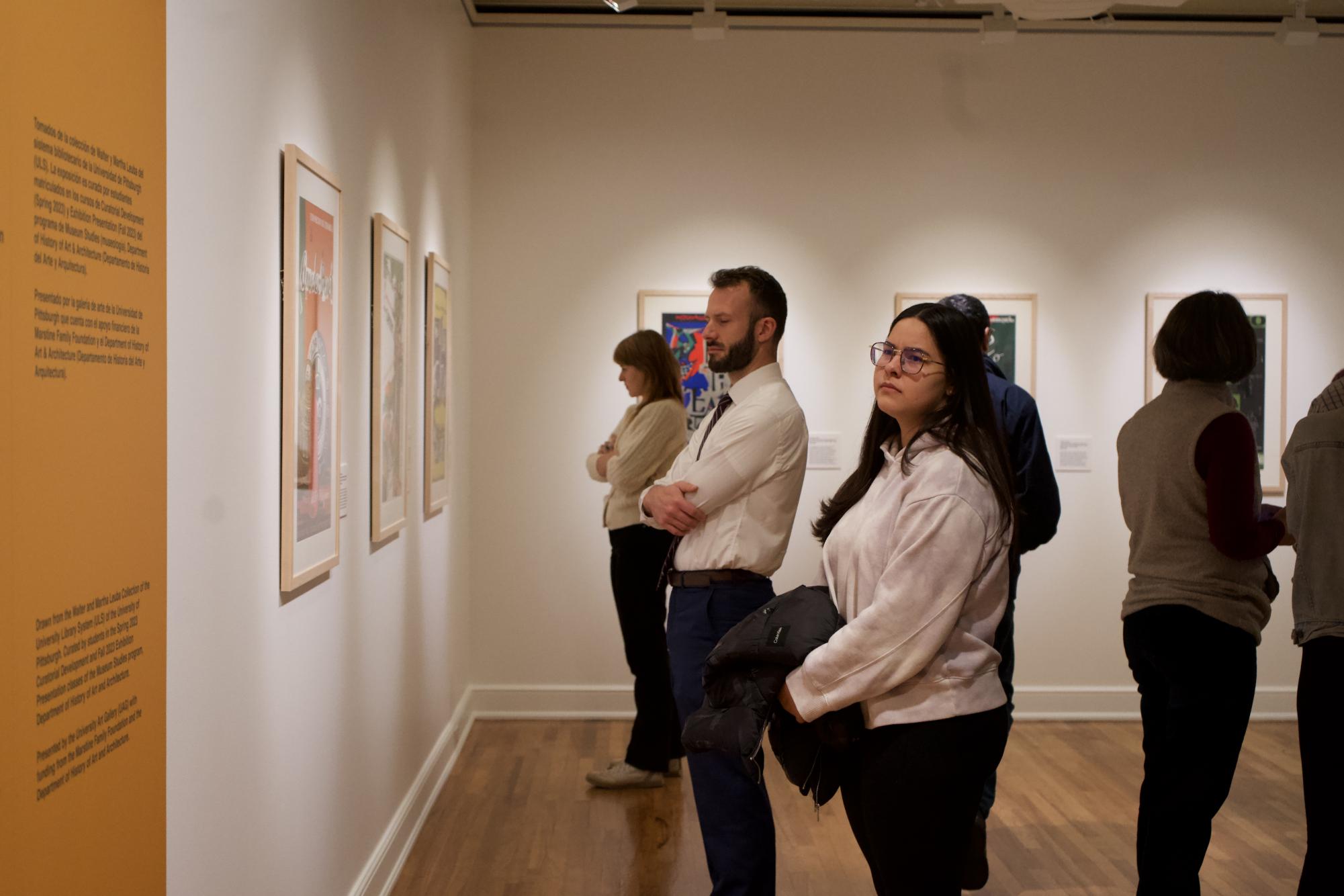New University Art Gallery exhibits highlight vibrant Caribbean culture


Attendees at the Fall Exhibition Reception in the Frick Fine Arts Building on Thursday.
Sylvia Rhor Samaniego, curator and director of the University Art Gallery, hopes that the gallery’s most recent exhibition celebrating Caribbean culture makes Latinx, Black and Brown students feel welcome at Pitt.
“I came to Pitt as a Latina many years ago. I really didn’t see any representations of my culture or even hear Spanish in the halls of this building,” Rhor Samaniego said. “It was difficult for me as a student. So when I came back as the director and curator, one of my main goals was to create a space where all students would feel safe and welcome and seen.”
Located in the Frick Fine Arts building, the exhibits run through March 1, 2024. One is “The Kingdom of This World Reimagined,”a traveling exhibit in partnership with Carlow University focusing on the Haitian Revolution. The other is an exhibition of 1950s and ‘60s Puerto Rican prints titled “Printing Culture,” curated by Pitt museum studies students. Connecting the two exhibits in the central rotunda is a site-specific installation by two Dominican artists featuring gold sculptures and projections on the floor and walls.
By walking through the gallery, attendees are not only experiencing Caribbean cultures, but a journey through the elements, Rhor Samaniego said.
“We move from land, to water, to sun. You move through the space and experience these interrelated ideas of Caribbean and Latinx culture, but you also move through these elements, through changes, thinking about the layered histories of Latinx and Caribbean identity,” Rhor Samaniego said.
The opportunity to explore identity was important for Pitt graduate and Hot Metal Bridge Fellow Camila Aguayo, who helped curate the exhibit. As someone from Puerto Rico, Aguayo said studying the effects of colonialism on the island in the 18th and 19th centuries through art was a significant learning experience for her.
“I just learned so much about how Puerto Ricans nationalized these mediums in order to show and create social change on the island, in order to move away from this industrial wave and this colonial rule that was being implemented and basically become proud of where they come from and being Puerto Rican,” Aguayo said.
Aguayo said Alex Taylor, associate professor in Pitt’s history of art and architecture department, found the displayed prints. Students in Pitt’s museum studies major researched the prints and placed them in the exhibition. The experience helps students gain real experience curating archival materials, Aguayo said.
“You get a taste from looking at an object, researching it, then framing it, then putting it on a wall, then writing the object label, and then studying the visitors that come into the space. So it really is a combination of everything,” Aguayo said.
Students curating an exhibit is an unusual and valuable offering from the museum studies department, Rhor Samaniego said.
“Students are infused in every single part of this gallery. I never had this as an undergraduate – that’s another reason that this is really gratifying,” Rhor Samaniego said. “These students are ready for a professional job in museums. I love to see this as an actual training ground for students to learn best practices and next practices, to be the next generation of museum professionals.”
Catherine Spiller, a junior art history and chemistry major, said students like her in Pitt’s Exhibition Presentation class learned outside of the classroom as well. She said she learned about screen printing techniques and the meaning behind the posters at a class in the basement of Frick.
“It was interesting to learn about the actual techniques of printing and learn a lot about not just the artist and the posters but what they were advertising, the different ballets and concerts and plays and how those were important in Puerto Rico,” Spiller said. “The posters are important here, but the actual things that they advertise were what the art was in Puerto Rico.”
Aguayo said she hopes the attendees of the exhibit learn something too.
“I really want people to get a little sense of the Caribbean. The Caribbean is so overlooked in the way we teach history and it’s such an amazing place because it’s a combination of Indigenous, African and Spanish traditions that creates this truly unique character and persona that is just spread out through these islands,” Aguayo said.
Rhor Samaniego agrees that everyone, even if they don’t have personal connections to the Caribbean, can feel connected to the exhibits. Above all, she said she hopes everyone who enters the gallery feels at home.
“I hope if they’re Latinos, they see themselves represented. If they’re not, I hope they see themselves represented. I hope that they come in and feel at home, and intrigued, and questioning but learning from the things they see,” Rhor Samaniego said. “I hope they just feel at home. Actually, that is the bottom line. Whether they like art or not I hope they feel at home, or as I would say, ‘en casa.’”
Recent Posts
Therese Pitman: Giving back to Pitt’s student-athletes with equality
Pitman is Pitt’s Director of Student Athlete Development where she helps student-athletes navigate their career…
Pitt speech and debate team heads to nationals
The William Pitt Debating Union, Pitt’s speech and debate team, sends students to both in-person…
Visuals: A Year in Review
The visuals desk had an interesting year. In the midst of the 2024 Presidential Election,…
De-stress events across campus offer students a break from studying
During finals week, departments across campus are offering wellness events to help students manage stress…
Pitt students share their summer plans
After a long and strenuous academic year, many students are excited to take a break.…
Column | Collaboration and connection make us better — yes, even in journalism
Today is the last day I will ever do this, and despite the amount of…

